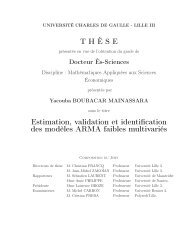A particle-in-Burgers model: theory and numerics - Laboratoire de ...
A particle-in-Burgers model: theory and numerics - Laboratoire de ...
A particle-in-Burgers model: theory and numerics - Laboratoire de ...
Create successful ePaper yourself
Turn your PDF publications into a flip-book with our unique Google optimized e-Paper software.
Mo<strong>de</strong>l <strong>and</strong> motivation Auxiliary steps Results h = 0: coupl<strong>in</strong>g h = 0: <strong>de</strong>f<strong>in</strong>ition, uniqueness h = 0: <strong>numerics</strong>, existence The coupled problem<br />
...Properties of the scheme...<br />
In what follows, we need a technical hypothesis (dissipativity at x = 0):<br />
(H) ∂a(∂ag(a, b)+∂bg(a, b)) 0, ∂b(∂ag(a, b)+∂bg(a, b)) 0;<br />
Lemma ( BVloc bound, Bürger, García, Karlsen, Towers )<br />
Let T > 0 <strong>and</strong> A > 0. Assume that u0 ∈ BV(R) <strong>and</strong> ∆x is small enough.<br />
Then, un<strong>de</strong>r the CFL condition <strong>and</strong> assumption (H), we have<br />
u∆(·,·)BV([0,T]×R\(−A,A)) 1<br />
Const(T,u0L ∞,u0BV(R),λ).<br />
A<br />
– estimate <strong>in</strong> BV(0, T; L 1 (R)) (i.e., time BV estimate <strong>in</strong> the mean ) from<br />
translation <strong>in</strong>variance + contraction (use Cr<strong>and</strong>all-Tartar lemma + (H))<br />
– mean-value theorem: for some r ∈ (0, A), u(·,±r)BV(0,T) const/A<br />
– look at our solution as solution to a Cauchy-Dirichlet problem<br />
with BV <strong>in</strong>itial <strong>and</strong> boundary data.<br />
Proposition (approximate Kato <strong>in</strong>equality)<br />
Let u∆, v∆ be solutions of the scheme. Let ϕ ∈ D([0, T)×R), ϕ 0. Then<br />
<br />
− (u∆−v∆) + ∂tϕ+Φ + (u∆, v∆)∂xϕ Rem(∆x,ϕ).<br />
R +<br />
R<br />
Arguments: monotonicity of the scheme, consistency , the BVloc <strong>in</strong> space<br />
bound
















